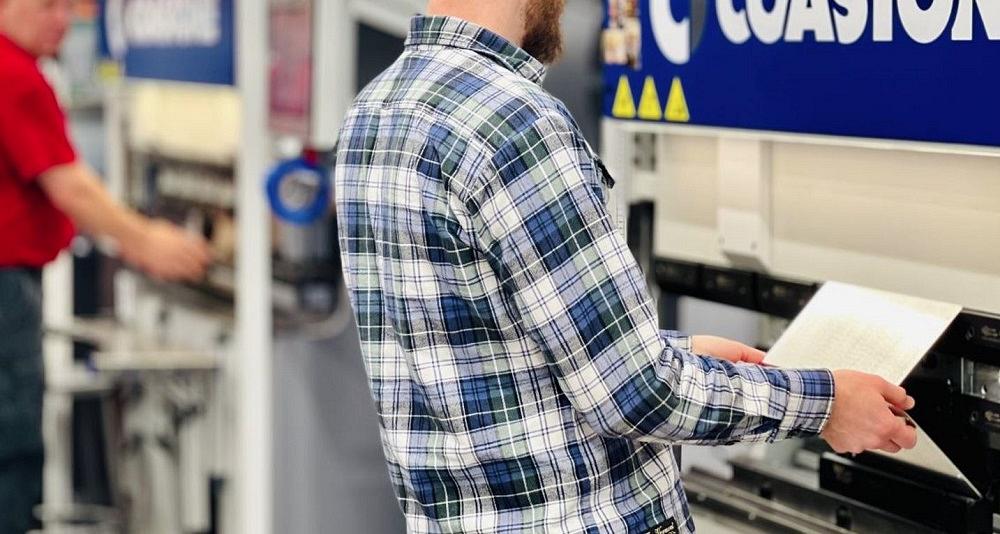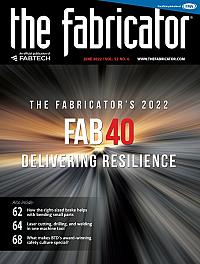President
- FMA
- The Fabricator
- FABTECH
- Canadian Metalworking
Categories
- Additive Manufacturing
- Aluminum Welding
- Arc Welding
- Assembly and Joining
- Automation and Robotics
- Bending and Forming
- Consumables
- Cutting and Weld Prep
- Electric Vehicles
- En Español
- Finishing
- Hydroforming
- Laser Cutting
- Laser Welding
- Machining
- Manufacturing Software
- Materials Handling
- Metals/Materials
- Oxyfuel Cutting
- Plasma Cutting
- Power Tools
- Punching and Other Holemaking
- Roll Forming
- Safety
- Sawing
- Shearing
- Shop Management
- Testing and Measuring
- Tube and Pipe Fabrication
- Tube and Pipe Production
- Waterjet Cutting
Industry Directory
Webcasts
Podcasts
FAB 40
Advertise
Subscribe
Account Login
Search
Strategies for bending small parts in a sheet metal manufacturing shop
Smaller parts often call for a right-sized press brake and other forming equipment
- By Bill Helinski
- June 7, 2022
- Article
- Bending and Forming
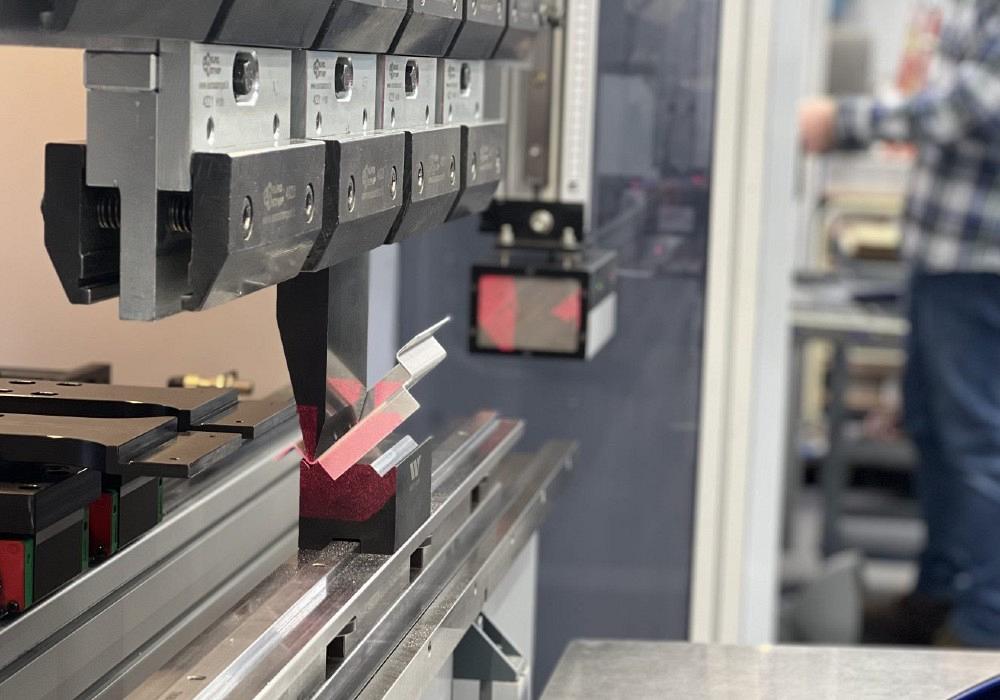
Forming small parts introduces a host of challenges, many of which can be overcome with right-sized equipment.
Imagine a forming department that processes a range of part geometries and thicknesses. It’s a typical day until a rush job enters the fray. The job has workpieces that require a sufficiently large press brake bed. The production manager rushes over to that large machine only to find it set up with a few narrow, segmented tools and an operator forming a large batch of small brackets. It’s time for a quick changeover.
Even so, the effect of that unexpected changeover sends ripples through the shop. The operator is late delivering those small parts, which means the job sits on a pallet near assembly, waiting for those last few small brackets to be formed.
This scenario can change if a fabricator develops a strategy for forming small parts. A critical element of this involves describing the nature of the shop’s product mix and the nature of the small parts the forming department runs, including part geometry and demand trends. From this, a shop then can identify the forming methods, tools, and technologies that would help the forming department produce more quality parts in less time, no matter how large or small those parts happen to be.
Challenges of Forming Small Parts
Historically, operating a press brake while forming tiny, complicated parts hasn’t been the safest job on the floor, especially if that operator worked on old equipment without modern safeguarding. Operators forming a small piece often have no choice but to position their hands very close to the tooling.
Ideally, they should be able to support small workpieces from underneath, sliding the tiny blank against the backgauge with their thumbs and fingers safely away from pinch points. A press brake with light curtains might see those fingers as an obstruction and stop the operation as a safety precaution. Some parts might be so small that, on some equipment, the only safe way an operator can form them is to position the blank on the tool and use palm buttons to actuate the ram. Left unsecured, the blank might not be flush against the gauging surfaces, which puts the bend in a slightly different location. This can throw the part out of tolerance, which in turn makes the whole operation less efficient.
Ergonomics and operator fatigue play major roles here too, though these aren’t as obvious as they are with extremely large parts. If someone sees multiple operators heaving a large workpiece as it swings upward to form an edge flange, they know the setup isn’t ideal. But small-parts forming doesn’t look too arduous, at least at first glance.
Still, operators who need to secure a small part on a large brake can find the job stressful and even intimidating. And if working with an older machine without close-proximity safeguarding, an operator (especially a tired one) with fingers too close to the bend line raises serious safety concerns.
Then comes the production inefficiencies, the most obvious being the problem of using the wrong manufacturing technology for the job, like a massive press brake for a tiny part. Forming small part after small part on a large press brake can be a serious choke point, stealing resources that could be better utilized for larger work.
Productivity problems compound if accuracy issues arise, especially considering the narrow, acute tools small workpieces often require. Air bending over an acute die produces a small radius and a setup that in general can be susceptible to angle variation. Some operations might resort to bottoming to achieve a repeatable angle, especially on older machines, but this introduces more tool wear as well as concerns about forming tonnage, especially if the operator uses a die width too narrow for the application.
Even without accuracy problems, operators still have to deal with handling numerous small parts. Consider the entire bending cycle, not only the ram movement (which can be slow on older hydraulic machines), but also the moves operators perform as they bend one small piece after another. They turn around, grasp a blank, form the piece, then turn around again to stack the formed part. Such movement probably can’t be avoided for larger workpieces, but alternatives exist for smaller ones.
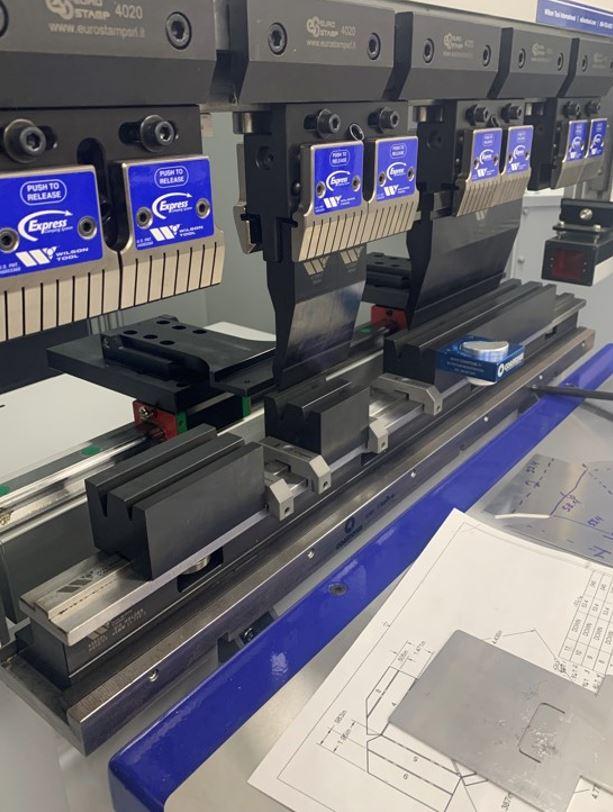
Press brakes with short bed lengths and tables in front of the forming bed are right-sized for the forming of small parts.
Better Together
As with anything else in the fab shop, the part mix should dictate the production strategy. If an operation processes a large quantity of small, identical (or at least similar) parts, all with one or two parallel bends, then those small parts could be formed all at once. They could be ganged together with micro-tabs or punched with tools that create “snap-apart” lines, which can minimize or eliminate the need for deburring. In effect, small parts don’t become “small” until they’re separated after forming.
Even if the formed pieces do need to be deburred after being snapped apart, forming parts all at once still can make sense. Think of all the reduced material handling, the reduced wear and tear on equipment, and, most important of all, less operator fatigue. The strategy truly can be a game-changer and sometimes help a shop win bids it otherwise couldn’t, especially for higher-volume work.
Although this gang-together strategy can work for simple brackets, it likely wouldn’t suit more complicated pieces with multiple bends at various orientations. For safe, productive forming of an array of complex parts, shops need to take four factors into consideration: the gauging, the press brake itself, the tooling, and the software that ties it all together.
Gauging Challenges
When small parts need to be formed within tight tolerances, an operator has little room for error. Problems with precision often start with bad gauging. An operator sometimes can have trouble sliding a very thin, small part securely against a backgauge. If the piece sits ever-so-slightly askew, the initial bend line can be slightly off, and the tolerance deviations stack up from there.
The right CNC backgauging can help here. Consider a 5-axis backgauge that moves in Z1 and Z2 (side to side across the bed) for staged setups using multiple toolsets. It also moves in R (up and down) which can be critical for guiding a workpiece through bump-forming. The backgauge position along the R axis helps the operator maintain a consistent pitch (distance between bumps) throughout the entire bumped radius.
The backgauge moves in X, of course (toward and away from the tooling), but it can also move in delta X, which can have a finger attachment that can be moved in and out independently. To form very small parts, some operations use the X axis as a backgauge and the delta-X axis as a side-gauge. Even if the gauge moves in delta-X just 1 or 2 in., that might be enough to provide a secure side-gauge for a small part.
Machine, Safeguarding, Tooling, and Software
Ball-screw-driven electric press brakes offer two elements that help small-piece forming tremendously. First is their positioning accuracy. Ever-so-slight overtravel of the ram can wreak havoc on precision, small-piece forming work.
Second is their speed and acceleration. Near immediate acceleration and deceleration means the operator isn’t waiting for the ram to achieve its working speed. This becomes even more important for small parts, where ram travel can be minimal. That immediate acceleration also means the bend program can maintain minimal open heights. The ram raises just far enough for the operator to position the workpiece, then commences the next bend.
Operators can sit on a stool, retrieve blanks stacked on a table extending from the brake bed, then place the finished part back on the table immediately after forming—no twisting, reaching, or other wasted motion. They also can retrieve small tools and quickly set up the next job, which could entail one or multiple toolsets.
To achieve this kind of productivity requires more than just a small brake, though. First, it needs the right safeguarding, ideally of the close-proximity variety. Common ones involve systems that ride on the side of the ram and emit laser beams or fields surrounding the punch tip.
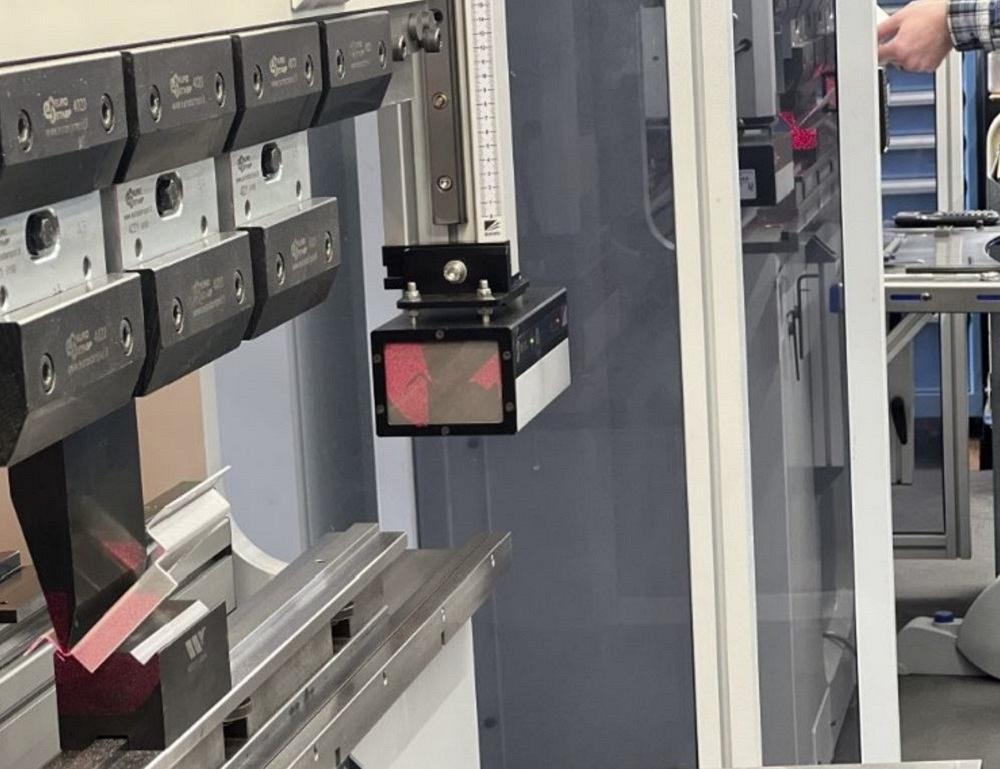
Small press brakes offer guarding, including hard barriers and close-proximity guarding that senses obstructions under the punch tip, to keep operators and nearby personnel safe.
Some systems include pressure-sensing that adds another layer of safety. If the machine knows it’s air-bending 16-ga. aluminum over a specific die width, it knows the tonnage it should be exerting during the bend cycle. If the operator mistakenly places, say, a piece of 0.25-in.-thick stainless steel between the tooling, the machine will stop as soon as the punch makes contact and applies pressure. The same would happen if the operator mistakenly installs a die too narrow for the job.
Second, the machine requires precision tooling. Placing low-quality tools onto a highly precise press brake is a bit like putting bald tires onto a Ferrari. You won’t get what you’re paying for. Angular variation can be amplified by the acute tools many small parts require. Again, having the wrong tooling for the job might make an operator resort to bottom bending. And by bottoming, an operator can wear tools prematurely and really doesn’t get the most out of the machine.
Precision-ground acute tools not only help achieve the short flanges that are common on small parts, they also help get the most out of an electric press brake’s ram repeatability. These machines allow the operator to move the ram in minute increments (a few thousandths of an inch) to dial in just the right depth of penetration to achieve the correct angle (accounting for springback).
That said, the application requirements should always drive tooling selection, regardless of the part size. A job that requires a larger radius will likely call for a larger die opening. Also, the physics of bending doesn’t change just because parts are small and ram moves are slight (at least relative to forming large parts over a wide V die). An acute die with a sharp die-shoulder radius might successfully form a short flange, but bending into acute dies can increase forming tonnage, especially for thicker material.
Software: Tying It All Together
Many operations might stage tooling on a small press brake so that it can bend either a complicated part in one setup or accept a variety of small parts throughout a shift. The operator needn’t spend time changing over, but simply call up the new program, run a test part, and commence the next job.
Modern machine controls show the application graphically, guiding operators through a job setup and bending sequence, making use of hydraulic clamping, tool indicator lights, and other worker aids to show what goes where.
Tying it all together is software, be it machine-OEM based or provided by a third party. The idea is to tie the entire blank-bend cycle together. Bending elongates metal, so a change in bending changes the blank size in laser cutting or punching. A micro-tab placement on a small part in a laser-cut nest can change a backgauging strategy on the press brake. A part’s orientation on the nest affects the grain direction, which in turn can affect bending, especially for ultra-precision work.
About the Ability to Respond
Consider again the scenario in which a conventional press brake is tied up forming a large batch of tiny parts, creating an operational choke point. First, think of product flow. If the parts do need to be produced at a certain volume to meet the demand of downstream processes, could the pieces be ganged together and formed in groups? Could some features be formed with form tools on the punch press, if available? Of the parts that remain, could the operation benefit from sending those jobs to a machine dedicated to small jobs?
Many operations might shy away from small press brakes because they’re concerned about utilization. After all, a press brake with a larger bed can form shorter parts, but a small machine can’t physically handle larger parts.
Problem is, customers aren’t paying for machine utilization; they’re paying for a fabricator’s ability to respond. Besides improving safety and ergonomics for operators, a machine dedicated to small workpieces can eliminate forming constraints, unleash capacity elsewhere in the bending department, and, hence, increase a shop’s ability to respond. And now more than ever, quick response really matters.
About the Author
Bill Helinski
82 Calvary St.
Waltham, MA 02453
781-893-3403
Related Companies
subscribe now

The Fabricator is North America's leading magazine for the metal forming and fabricating industry. The magazine delivers the news, technical articles, and case histories that enable fabricators to do their jobs more efficiently. The Fabricator has served the industry since 1970.
start your free subscription- Stay connected from anywhere

Easily access valuable industry resources now with full access to the digital edition of The Fabricator.

Easily access valuable industry resources now with full access to the digital edition of The Welder.

Easily access valuable industry resources now with full access to the digital edition of The Tube and Pipe Journal.
- Podcasting
- Podcast:
- The Fabricator Podcast
- Published:
- 04/16/2024
- Running Time:
- 63:29
In this episode of The Fabricator Podcast, Caleb Chamberlain, co-founder and CEO of OSH Cut, discusses his company’s...
- Trending Articles
Tips for creating sheet metal tubes with perforations

JM Steel triples capacity for solar energy projects at Pennsylvania facility

Are two heads better than one in fiber laser cutting?

Supporting the metal fabricating industry through FMA

Omco Solar opens second Alabama manufacturing facility

- Industry Events
16th Annual Safety Conference
- April 30 - May 1, 2024
- Elgin,
Pipe and Tube Conference
- May 21 - 22, 2024
- Omaha, NE
World-Class Roll Forming Workshop
- June 5 - 6, 2024
- Louisville, KY
Advanced Laser Application Workshop
- June 25 - 27, 2024
- Novi, MI
























